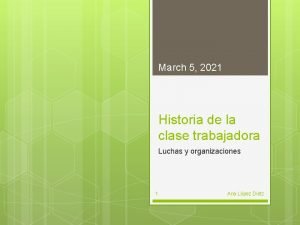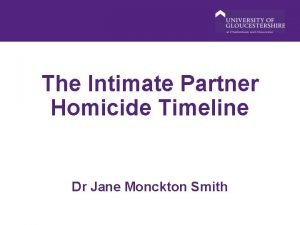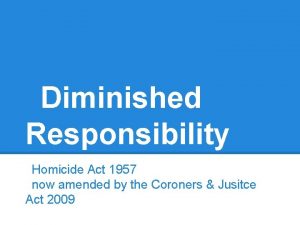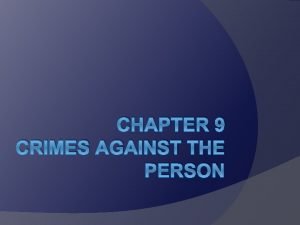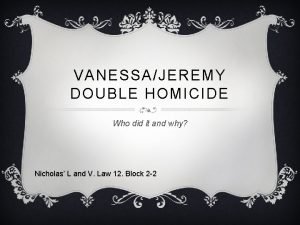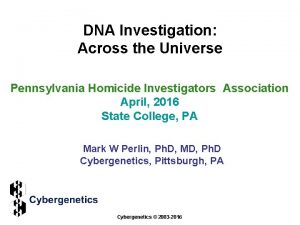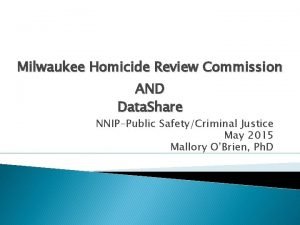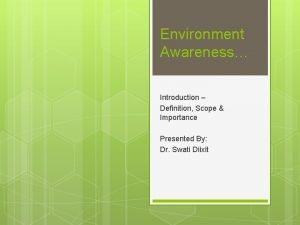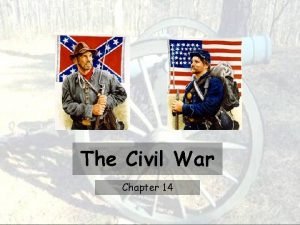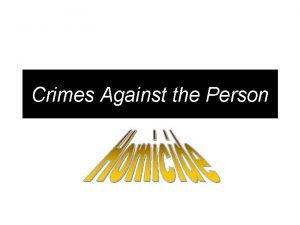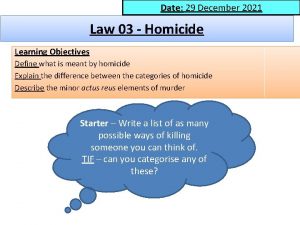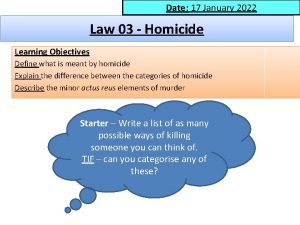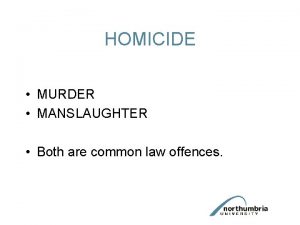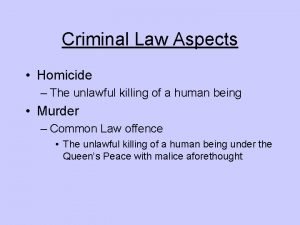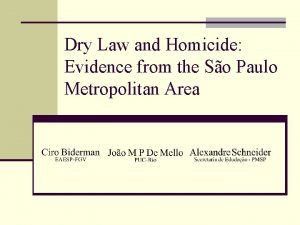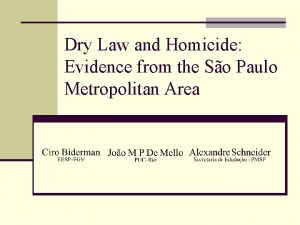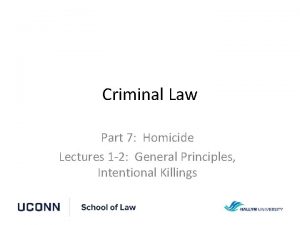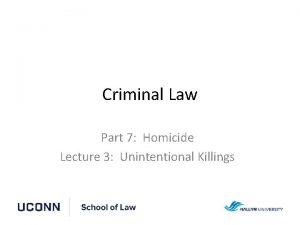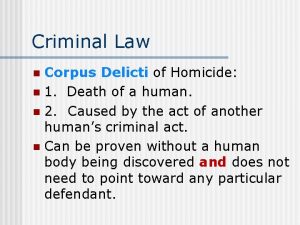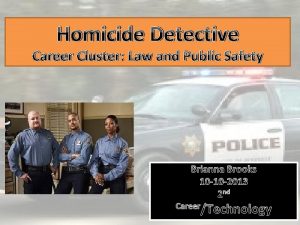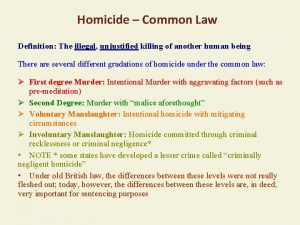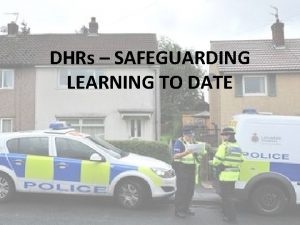Date 11 March 2021 Date Law 03 Homicide
















![R v Gibbins & Proctor [1918] 13 Crim App Rep 184 D and his R v Gibbins & Proctor [1918] 13 Crim App Rep 184 D and his](https://slidetodoc.com/presentation_image_h/352006267c0993f9da1a4988b942b3e6/image-17.jpg)


![Attorney-General's Reference (No. 3 of 1994) [1997] 3 All ER 936 D stabbed child's Attorney-General's Reference (No. 3 of 1994) [1997] 3 All ER 936 D stabbed child's](https://slidetodoc.com/presentation_image_h/352006267c0993f9da1a4988b942b3e6/image-20.jpg)

![R v Malcherek & Steel, [1981] 2 All ER Two separate appeals were heard R v Malcherek & Steel, [1981] 2 All ER Two separate appeals were heard](https://slidetodoc.com/presentation_image_h/352006267c0993f9da1a4988b942b3e6/image-22.jpg)
![R v Inglis [2011] 1 WLR 1110 Court of Appeal The appellant appealed against R v Inglis [2011] 1 WLR 1110 Court of Appeal The appellant appealed against](https://slidetodoc.com/presentation_image_h/352006267c0993f9da1a4988b942b3e6/image-23.jpg)


- Slides: 25

Date: 11 March 2021 Date: Law 03 - Homicide Learning Objectives Define what is meant by homicide Explain the difference between the categories of homicide Describe the minor actus reus elements of murder Starter – Write a list of as many possible ways of killing someone you can think of. TIF – can you categorise any of these?

Homework due Wednesday • Read pages 4 -9 • Take notes/annotate your handout • Revise the elements of the AR of murder and the key authority for a test

Look at the different scenarios: D stabs V to death during a pub fight. D, a railway guard, fails to ensure all of the doors to a train carriage are close. V falls to her death Jon taunts Tim over the death of his son, Tim kills Jon as a result Andrew poisons his wife to get the insurance money D, pushes V during a heated argument, V falls over bangs his head and dies D, a sexual psychopath, rapes and murders V to satisfy his sexual urges D sets fire to his house to claim the insurance money, his children are inside and they all die Peter catches Simon having an affair with his wife and shoots them both – What is similar about them all? – What is different about them? – How many different types of deaths do you think you can see? – Which are the most culpable? D, the owner of a haulage company, fails to allow his drivers the correct amount of rest. One of them crashes whilst driving killing a family of four Lana, a diabetic, forgets to take her insulin and during a diabetic episode hits her husband on the head with a brick killing him 3

Homicide – A family of offences Homicide: family of offences linked by D causing death Murder Voluntary Manslaughter Requires intent to kill or commit GBH Although intent to kill, reduced through circumstances: Diminished Responsibility: s. 2 Homicide Act 1957 (as amended) Loss of Control: s. 54 Coroners and Justice Act 2009 Involuntary Manslaughter No intent to kill but blameworthy conduct: Constructive/unlawful act manslaughter Gross negligence manslaughter Subjective reckless manslaughter Other Infanticide: victim is under 1 year old Causing death by dangerous driving : s. 1 Road Traffic Act 1988 4

Murder – The Definition Try to come up with your own definition of murder. Remember to divide your answer into AR & MR. 5

Murder – The Definition Murder is a common law offence • • Unlawful killing Of a person Within the Queen’s peace With malice aforethought Murder is when a man of sound memory and of the age of discretion, unlawfully killeth within any county of the realm any reasonable creature in rerum natura under the king's peace, with malice aforethought, either expressed by the party or implied by law…. . ” "(. . . so that the wounded party shall die of the wound or hurt, (within a year and a day of the same). " This last sentence removed by The Law Reform (Year and a Day Rule) Act 1996 17 th Century rule - Coke's Institutes. 6

The Law Reform (Year and a Day Rule) Act 1996 If the 'cause' of death occurs more than 3 years before the victim died or D has already been convicted of some other offence (e. g. grievous bodily harm) in relation to the acts that caused the death the consent of the Attorney General must be secured before prosecution can be brought. Otherwise, the normal rules of causation apply. Can you work out why this Law was necessary? 7

Committed Anywhere S. 9 Offences Against the Person Act 1861 Murder or manslaughter abroad. Where any murder or manslaughter shall be committed on land out of the United Kingdom, whether within the Queen’s dominions or without, and whether the person killed were a subject of Her Majesty or not, every offence committed by any subject of Her Majesty in respect of any such case, whether the same shall amount to the offence of murder or of manslaughter, . . . , may be dealt with, inquired of, tried, determined, and punished. . . in England or Ireland. . . : Provided, that nothing herein contained shall prevent any person from being tried in any place out of England or Ireland for any murder or manslaughter committed out of England or Ireland, in the same manner as such person might have been tried before the passing of this Act. 8

Punishment The Murder (Abolition of Death Penalty) Act 1964, says that a person convicted of murder must be sentenced to life imprisonment. "Sentenced" to life does not mean "serve" a sentence of imprisonment for the rest of their life. In practice, most are released after 10 - 15 years "on licence" which means they can be recalled to prison for many reasons. So, part of the life sentence is served in prison, and the remainder served not in prison. But…what major law-changing decision was made in the case of the killers of Lee Rigby? http: //www. independent. co. uk/news/uk/crime/wholelifesentences-life-means-life-for-worst-offenders-ruled-legal-bycourt-of-appeal-9135538. html 9

Death and Sportsmen indulging in their sporting past times consent to those inevitable injuries that occur as a result of contact sports. R v Bruce (1847) established that a murder charge would result if the death were caused by above average violence in the 'game' or non-adherence to the rules of the game. 10

Doctors and Death The mercy killing of a terminally ill patient does not provide any defence, no matter how compassionate. Doctors who kill are murderers. R v Cox (1992). Click on the picture to take you an overview of this case 11

Cox, R v (1992) Winchester Crown Court, Ognall J In 1991 Lillian Boyes, then 70, entered the Royal Hampshire County Hospital. Cox was her consultant and had been treating Boyes for 13 years. As her rheumatoid arthritis became worse, she pleaded with him to end her life. According to the hospital chaplain, 'When anyone touched her you could hear the bones move about in their joints. The sound will stay with me to the grave’. In August 1991, he administered an injection of two ampoules of potassium chloride, in order to stop her heart. After she died, Patrick, one of her sons, thanked Cox. In Cox's view, he probably shortened her life by "between 15 minutes and an hour. ” Cox entered the amount used in the hospital log - twice the amount needed to cause death. It was then noticed by a nurse, who reported it. Cox signed the cause of death as having been bronchial pneumonia. Cox was arrested for attempted murder and suspended for 18 months by the hospital, though he was allowed to teach at another hospital and continue his private practice. Principle – Cox was tried at Winchester Crown Court in September 1992 by Mr Justice Ognall. Cox was charged with attempted murder, since it was impossible to conclusively prove that the injection he gave killed her. He was given a 12 -month suspended sentence. Boyes' family supported his actions throughout the trial. 12

Plenary Read this case and see if you can find an exception to the rule on the last slide about doctors and euthanasia Annie Lindsell Click on the picture or name box to take you an overview of the complex issues and give you the answer 13

Date: 11 March 2021 Date: Murder – Actus Reus (1) Learning Objectives Describe cases that illustrate the actus reus of murder Begin to…Explain the rules and issues with respect to causation and murder Starter: Can you think of any killings that may be lawful?

Unlawful Killing Some killings may be lawful 1. Authorised by War 2. Administering 3. Withdrawal of 4. Necessity, Self – Dr Bodkin. Adams Anthony Bland Mrs Attard (re A (2001) Who applied for Anthony to be able to die? Why did the court decide to allow one of these twins to die? Pain Relief Treatment Defence, Po. C Pte Lee Clegg But what does Clegg tell us about this lawfulness? What does Devlin Say about pain relief in Bodkin -Adams? 15

Omissions Most cases will present no problems But death may be as a result of an omission or failure to act If D has duty to the other person then actus reus may be present Most cases of homicide by omission have resulted in manslaughter convictions One clear reported case however, is a familiar one: R v Gibbins and Proctor (1918) Why was the mens rea element of this case withholding food with intent to cause GBH and why do you think this was important? 16
![R v Gibbins Proctor 1918 13 Crim App Rep 184 D and his R v Gibbins & Proctor [1918] 13 Crim App Rep 184 D and his](https://slidetodoc.com/presentation_image_h/352006267c0993f9da1a4988b942b3e6/image-17.jpg)
R v Gibbins & Proctor [1918] 13 Crim App Rep 184 D and his common law wife failed to feed the man's 7 year-old child, Nelly, and she died from starvation. The woman hated Nelly, and was clearly the moving force. Held – Where there is the duty to act, failure to do so can lead to liability even for murder if the necessary mens rea is present. The woman was held to be liable because, while the child was not hers, she was living with the man and had accepted his money for food. The courts regarded the parent's duty towards a young child as so self-evident as not to require analysis or authority. 17

In rerum natura … what? 1. When is a human being not a human being? 2. Can you think of the two occasions when this is not so? 3. Can you think of any groups these two definitions might offend? 4. Why do you think this is a legal definition and not a moral or medical one? 18

A reasonable creature in being Foetuses and brain dead at two extremes Foetus – only ‘in being’ when expelled from mother’s body, and has an independent existence. No decision yet on if the foetus is still attached to the umbilical cord But what happens if the foetus is injured inside, survives until born then dies? What is the verdict likely to be in cases like this though? Why? AG’s Reference (No. 3 of 1994) (1997) 19
![AttorneyGenerals Reference No 3 of 1994 1997 3 All ER 936 D stabbed childs Attorney-General's Reference (No. 3 of 1994) [1997] 3 All ER 936 D stabbed child's](https://slidetodoc.com/presentation_image_h/352006267c0993f9da1a4988b942b3e6/image-20.jpg)
Attorney-General's Reference (No. 3 of 1994) [1997] 3 All ER 936 D stabbed child's mother whilst pregnant. Child lived for only 121 days. Her premature birth was caused by the injuries that her mother received when the defendant stabbed her. On his own admission D intended to cause the woman grievous bodily harm. So the mens rea for murder was present, if the death of the mother had been the result of his act: Held: Where a child is born alive, and dies later from injuries inflicted while in utero. - Murder – No - Manslaughter - Yes. If the child dies because of injury to the mother rather than injury to the foetus Murder – No - Manslaughter – No D could be guilty of manslaughter, but not murder (no intent towards the child). 20

A reasonable creature in being A person ceases to be a human being when their brain stem ceases to be active irrespective of whether they are being kept alive by artificial means. In these instances doctors can switch off life support machines. If do they are not liable. Malcherek and Steel (1981) But what about serious disability/illness? R v Inglis (2011) Click on the picture or name to take you to the news story. 21
![R v Malcherek Steel 1981 2 All ER Two separate appeals were heard R v Malcherek & Steel, [1981] 2 All ER Two separate appeals were heard](https://slidetodoc.com/presentation_image_h/352006267c0993f9da1a4988b942b3e6/image-22.jpg)
R v Malcherek & Steel, [1981] 2 All ER Two separate appeals were heard together. In Malcherek the defendant had stabbed his wife. In Steel the defendant was accused of sexually assaulting and beating a woman over the head with a stone. In both cases the victims had been taken to hospital and placed on life support machines. The doctors in the respective cases later switched off the life support machines as both victims were not showing any activity in their brain stem. The defendants sought to argue that the doctors' actions constituted a novus actus interveniens which broke the chain of causation. Held - Convictions upheld The test of death is where the brain stem has died. Thus at the time of switching off the machine, the victims were already dead. The doctors could not therefore be the cause of death. 22
![R v Inglis 2011 1 WLR 1110 Court of Appeal The appellant appealed against R v Inglis [2011] 1 WLR 1110 Court of Appeal The appellant appealed against](https://slidetodoc.com/presentation_image_h/352006267c0993f9da1a4988b942b3e6/image-23.jpg)
R v Inglis [2011] 1 WLR 1110 Court of Appeal The appellant appealed against her conviction for murdering her son Thomas had suffered serious head injuries when he had fallen out of an ambulance. He had undergone lifesaving surgery which removed part of his skull which resulted in severe head and facial disfigurement. He was in a vegetative state but doctors were hopeful that he would make a recovery. The appellant, however, was convinced that his vegetative state was permanent. She became obsessive and believed he was in pain and wanted to end his suffering. She injected him with a lethal dose of heroin with the intention to kill. She appealed against her conviction. Held - Her conviction was upheld. “the law does not recognise the concept implicit in the defence statement that Thomas Inglis was "already dead in all but a small physical degree". The fact is that he was alive, a person in being. However brief the time left for him, that life could not lawfully be extinguished. Similarly, however disabled Thomas might have been, a disabled life, even a life lived at the extremes of disability, is not one jot less precious than the life of an able-bodied person. ” 23

Causation 1. Covered extensively in lesson on causation 2. Need to prove direct and unbroken link between D’s act and criminal consequence 3. Factual and legal causation required 4. Factual – death would not have happened but for conduct of D 5. Legal – operating and substantial cause 6. If chain of causation broken no liability for homicide h/w Read by Friday! 24

Plenary Using only the material you have read so far in this chapter, do you think that the actus reus of murder is present in the following cases? Give reasons for your opinions. Arnold and Bert are steeplejacks. High up on a factory chimney, Bert pulls out a gun, points it at Arnold, and says that he is going to kill him for having an affair with his wife. Arnold lunges at Bert to knock the gun from his hand, and in doing so causes Bert to fall backwards off the scaffolding to his death. Eric, during the course of an argument, stabs his pregnant girlfriend. She recovers, but gives birth to their child prematurely. As a result of the premature birth, the child dies shortly afterwards. Cheryl has agreed to look after her aged uncle Dennis. He is dependent on various prescription drugs, but Cheryl, tired of the responsibility towards him, deliberately fails to get them for him. As a result of this, he dies. 25
 March march dabrowski
March march dabrowski Summary period: march 2021 quiz
Summary period: march 2021 quiz March 5 2021
March 5 2021 Dr jane monckton smith 8 stages
Dr jane monckton smith 8 stages Overt vs covert behavior
Overt vs covert behavior What is homicide
What is homicide Homicide act 1957
Homicide act 1957 Homicide meaning
Homicide meaning Mafia hula hoops cold war
Mafia hula hoops cold war Double homicide
Double homicide Arizona homicide investigators association
Arizona homicide investigators association Milwaukee homicide review commission
Milwaukee homicide review commission Newton's first law and second law and third law
Newton's first law and second law and third law Si unit of newton's first law
Si unit of newton's first law Boyles law
Boyles law Avogadro's law constant
Avogadro's law constant Dividend payment
Dividend payment What is ex dividend date
What is ex dividend date World environment day date
World environment day date Grihalakshmi magazine march 2019
Grihalakshmi magazine march 2019 March 30 1853
March 30 1853 Genetic engineering conclusion
Genetic engineering conclusion March 1917 revolution
March 1917 revolution Abraham lincoln
Abraham lincoln Sherman's march significance
Sherman's march significance Path of sherman's march to the sea
Path of sherman's march to the sea


